Like the majority of the Marantaceae, the Fire flag is originally from tropical America, between Florida and Argentina, where it is happy in the very humid zones, on the banks of rivers, ponds, and pools. It was introduced in Europe in the 17th century to decorate ornamental ponds. In effect, it is its delicate, yet dense foliage which appealed to the gardeners. This erect plant, which can grow to three metres tall, has big leaves on a long peduncle grouped at the base in the form of a graceful bouquet; the leaves of the species Thalia geniculate which we photographed in Luang Prabang, have a red border. The flowers are much more discreet, but strangely forming an inflorescence among the most complex of this family; the floral spike has primary angular bracts and two terminal bracts support the little twin flowers in two compact valves; the three-petaled corolla is violet and only opens for one day. The unusual aspect of this floral spike has prompted the Latin name « geniculata », « geniculate »: bent and forming the angle of a knee.
The thalia is quite rare in Laos, contrary to Thailand, where it is found in numerous ornamental lakes; it has been named kluai mai man. However, in Laos, a very close species is called kha: its leaves are smaller it has a different white inflorescence, and it relates to thalia cannaeformis.
We can recommend to our readers that they plant this Marantaceae in their ponds or lakes, because it gives the water an important amount of oxygen and is liked by the fish which hide in it, also the frogs and snails.
Comme la plupart des Marantacées, la thalie est originaire d’Amérique tropicale, entre la Floride et l’Argentine où elle se plait dans les zones très humides, en bord des rivières, des étangs et des mares. Elle a été introduite en Europe, dès le XVIIème siècle, pour y décorer les pièces d’eau. C’est en effet son feuillage à la fois léger et dense qui a plu aux jardiniers. Cette plante dressée, qui peut atteindre trois mètres de haut, a de grandes feuilles lancéolées sur un long pédoncule groupées à la base en forme de gracieux bouquet ; dans l’espèce Thalia geniculata que nous avons photographiée à Louang Prabang ces feuilles sont bordées d’un liseré rouge. Les fleurs sont beaucoup plus discrètes mais très étranges formant une inflorescence parmi les plus complexes de cette famille; l’épi floral est muni de bractées primaires anguleuses et de deux bractées terminales soutenant des petites fleurs jumelles dans deux valves compactes; la corolle à trois pétales est violette et ne s’ouvre qu’un seul jour. L’aspect inhabituel de cet épi a induit le nom latin « geniculata », « géniculé » : plié en faisant un angle en forme de genou.
Au Laos, la thalie est assez rare, contrairement à la Thaïlande où elle habite de nombreuses pièces d’eau ; on l’y nomme kluai mai man. Cependant, une espèce très voisine est nommée kha en lao, elle a des feuilles plus petites et une inflorescence blanche différente, il s’agit de thalia cannaeformis.
On peut recommander à nos lecteurs de planter cette marantacée dans leur bassin ou leur mare car elle apporte à l’eau une quantité d’oxygène importante et elle est très appréciée des poissons qui s’y cachent, des grenouilles et des escargots.
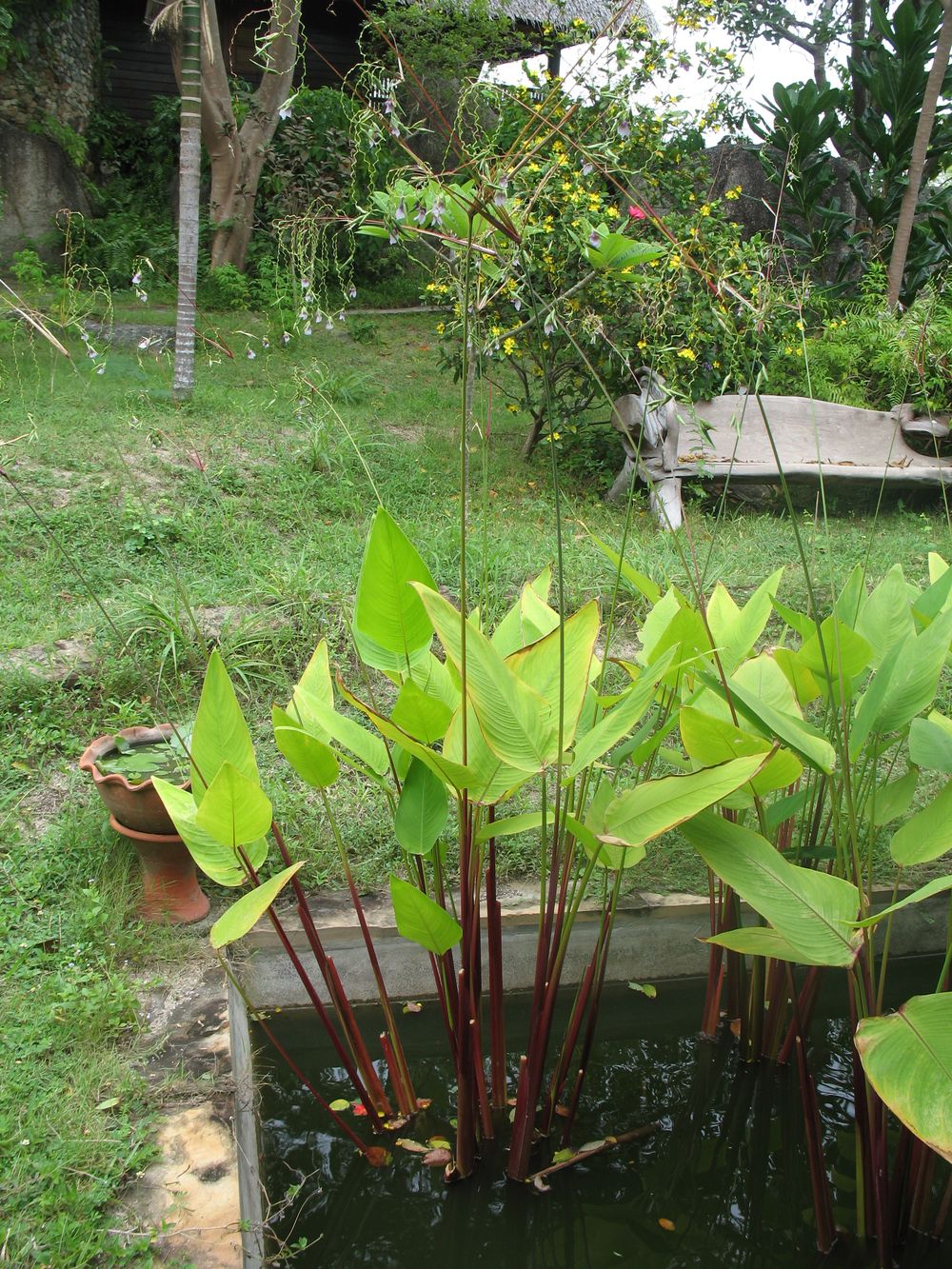
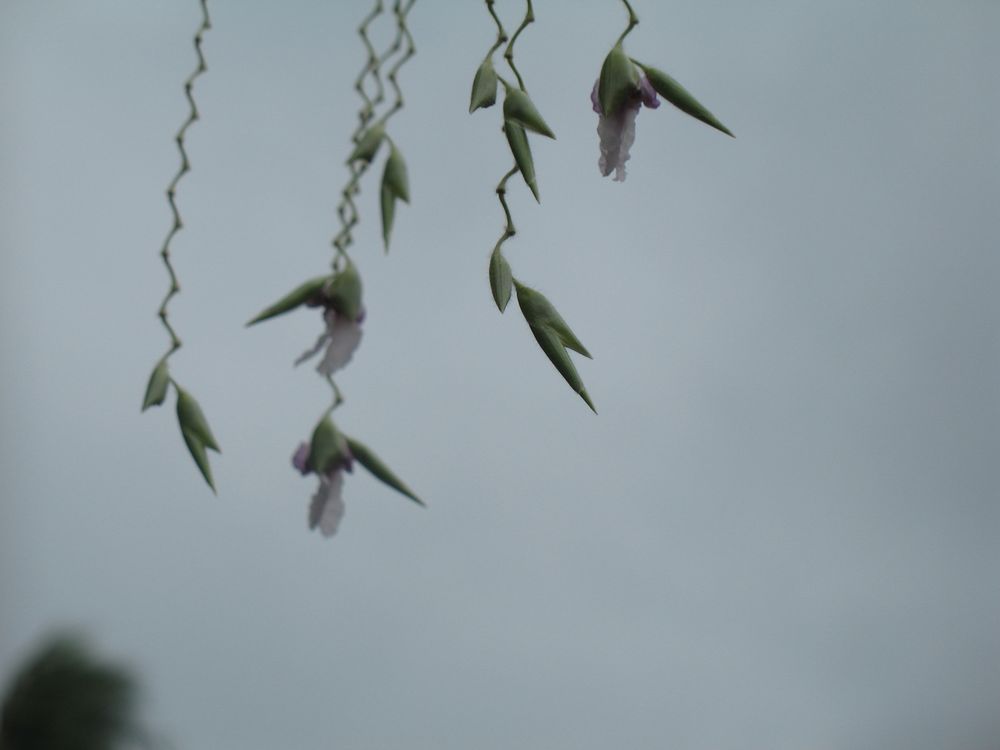
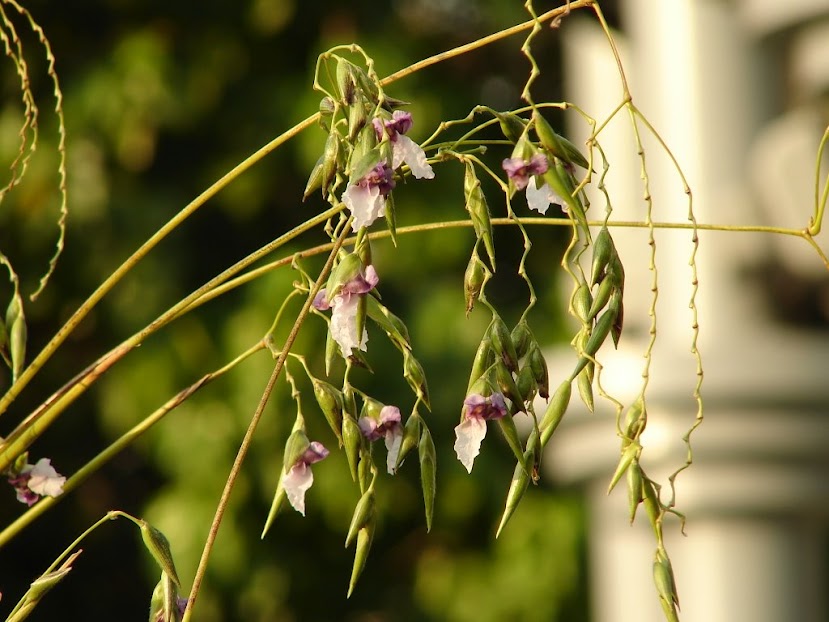
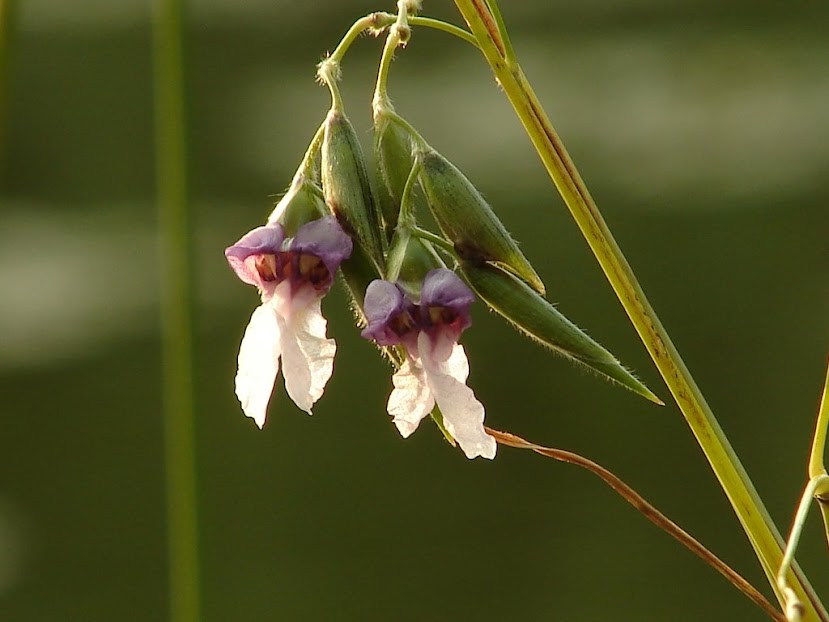
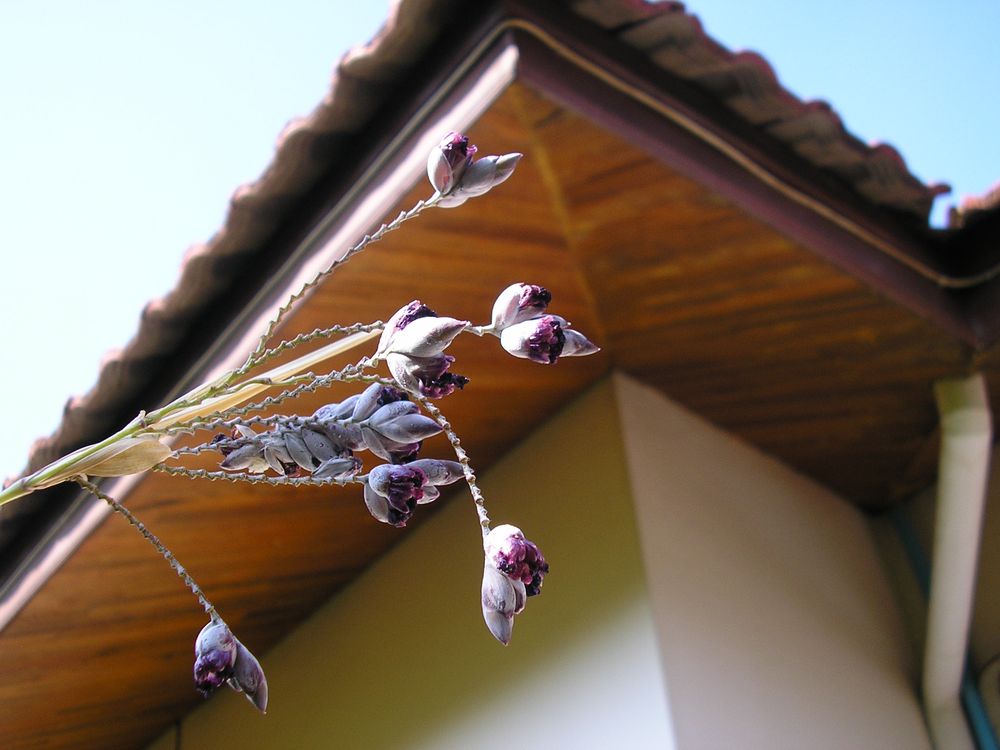
Like the majority of the Marantaceae, the Fire flag is originally from tropical America, between Florida and Argentina, where it is happy in the very humid zones, on the banks of rivers, ponds, and pools. It was introduced in Europe in the 17th century to decorate ornamental ponds. In effect, it is its delicate, yet dense foliage which appealed to the gardeners. This erect plant, which can grow to three metres tall, has big leaves on a long peduncle grouped at the base in the form of a graceful bouquet; the leaves of the species Thalia geniculate which we photographed in Luang Prabang, have a red border. The flowers are much more discreet, but strangely forming an inflorescence among the most complex of this family; the floral spike has primary angular bracts and two terminal bracts support the little twin flowers in two compact valves; the three-petaled corolla is violet and only opens for one day. The unusual aspect of this floral spike has prompted the Latin name « geniculata », « geniculate »: bent and forming the angle of a knee.
The thalia is quite rare in Laos, contrary to Thailand, where it is found in numerous ornamental lakes; it has been named kluai mai man. However, in Laos, a very close species is called kha: its leaves are smaller it has a different white inflorescence, and it relates to thalia cannaeformis.
We can recommend to our readers that they plant this Marantaceae in their ponds or lakes, because it gives the water an important amount of oxygen and is liked by the fish which hide in it, also the frogs and snails.
Comme la plupart des Marantacées, la thalie est originaire d’Amérique tropicale, entre la Floride et l’Argentine où elle se plait dans les zones très humides, en bord des rivières, des étangs et des mares. Elle a été introduite en Europe, dès le XVIIème siècle, pour y décorer les pièces d’eau. C’est en effet son feuillage à la fois léger et dense qui a plu aux jardiniers. Cette plante dressée, qui peut atteindre trois mètres de haut, a de grandes feuilles lancéolées sur un long pédoncule groupées à la base en forme de gracieux bouquet ; dans l’espèce Thalia geniculata que nous avons photographiée à Louang Prabang ces feuilles sont bordées d’un liseré rouge. Les fleurs sont beaucoup plus discrètes mais très étranges formant une inflorescence parmi les plus complexes de cette famille; l’épi floral est muni de bractées primaires anguleuses et de deux bractées terminales soutenant des petites fleurs jumelles dans deux valves compactes; la corolle à trois pétales est violette et ne s’ouvre qu’un seul jour. L’aspect inhabituel de cet épi a induit le nom latin « geniculata », « géniculé » : plié en faisant un angle en forme de genou.
Au Laos, la thalie est assez rare, contrairement à la Thaïlande où elle habite de nombreuses pièces d’eau ; on l’y nomme kluai mai man. Cependant, une espèce très voisine est nommée kha en lao, elle a des feuilles plus petites et une inflorescence blanche différente, il s’agit de thalia cannaeformis.
On peut recommander à nos lecteurs de planter cette marantacée dans leur bassin ou leur mare car elle apporte à l’eau une quantité d’oxygène importante et elle est très appréciée des poissons qui s’y cachent, des grenouilles et des escargots.










Like the majority of the Marantaceae, the Fire flag is originally from tropical America, between Florida and Argentina, where it is happy in the very humid zones, on the banks of rivers, ponds, and pools. It was introduced in Europe in the 17th century to decorate ornamental ponds. In effect, it is its delicate, yet dense foliage which appealed to the gardeners. This erect plant, which can grow to three metres tall, has big leaves on a long peduncle grouped at the base in the form of a graceful bouquet; the leaves of the species Thalia geniculate which we photographed in Luang Prabang, have a red border. The flowers are much more discreet, but strangely forming an inflorescence among the most complex of this family; the floral spike has primary angular bracts and two terminal bracts support the little twin flowers in two compact valves; the three-petaled corolla is violet and only opens for one day. The unusual aspect of this floral spike has prompted the Latin name « geniculata », « geniculate »: bent and forming the angle of a knee.
The thalia is quite rare in Laos, contrary to Thailand, where it is found in numerous ornamental lakes; it has been named kluai mai man. However, in Laos, a very close species is called kha: its leaves are smaller it has a different white inflorescence, and it relates to thalia cannaeformis.
We can recommend to our readers that they plant this Marantaceae in their ponds or lakes, because it gives the water an important amount of oxygen and is liked by the fish which hide in it, also the frogs and snails.
Comme la plupart des Marantacées, la thalie est originaire d’Amérique tropicale, entre la Floride et l’Argentine où elle se plait dans les zones très humides, en bord des rivières, des étangs et des mares. Elle a été introduite en Europe, dès le XVIIème siècle, pour y décorer les pièces d’eau. C’est en effet son feuillage à la fois léger et dense qui a plu aux jardiniers. Cette plante dressée, qui peut atteindre trois mètres de haut, a de grandes feuilles lancéolées sur un long pédoncule groupées à la base en forme de gracieux bouquet ; dans l’espèce Thalia geniculata que nous avons photographiée à Louang Prabang ces feuilles sont bordées d’un liseré rouge. Les fleurs sont beaucoup plus discrètes mais très étranges formant une inflorescence parmi les plus complexes de cette famille; l’épi floral est muni de bractées primaires anguleuses et de deux bractées terminales soutenant des petites fleurs jumelles dans deux valves compactes; la corolle à trois pétales est violette et ne s’ouvre qu’un seul jour. L’aspect inhabituel de cet épi a induit le nom latin « geniculata », « géniculé » : plié en faisant un angle en forme de genou.
Au Laos, la thalie est assez rare, contrairement à la Thaïlande où elle habite de nombreuses pièces d’eau ; on l’y nomme kluai mai man. Cependant, une espèce très voisine est nommée kha en lao, elle a des feuilles plus petites et une inflorescence blanche différente, il s’agit de thalia cannaeformis.
On peut recommander à nos lecteurs de planter cette marantacée dans leur bassin ou leur mare car elle apporte à l’eau une quantité d’oxygène importante et elle est très appréciée des poissons qui s’y cachent, des grenouilles et des escargots.


